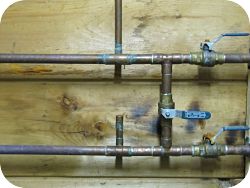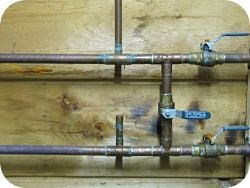 With temperatures this morning well below zero, we expect to be getting calls about frozen water pipes. It's not unusual after a bitterly cold night like we had last night for homeowners to turn on the water and see a trickle of water then nothing. If this happens to you, your pipes may be in danger of bursting and will need to be thawed. We've outlined steps below on how to thaw frozen pipes. If in doubt, we recommend calling a professional.
With temperatures this morning well below zero, we expect to be getting calls about frozen water pipes. It's not unusual after a bitterly cold night like we had last night for homeowners to turn on the water and see a trickle of water then nothing. If this happens to you, your pipes may be in danger of bursting and will need to be thawed. We've outlined steps below on how to thaw frozen pipes. If in doubt, we recommend calling a professional.
Frozen pipes are serious business. According to State Farm Insurance, over a quarter million American families experience damage to their homes each winter due to pipes that freeze and burst. Both copper and PVC pipes can burst.
Also, if you're like many Central New York homeowners who take a winter vacation or travel south to escape the cold, when you leave home there are steps you should take to prevent potential water damage to your home caused by frozen pipes. Those steps are described below, too.
Take the following steps to thaw frozen water pipes:
- Turn off the main water supply to prevent damage.
- Find the frozen pipe. Open the taps in the house. If the water isn’t running anywhere in the house, the pipe near the water heater may be frozen. Touch the meter and the exposed pipes, it they are very cold, they are probably frozen. If the water is running in one part of the house, then the frozen pipe may be located in an outside wall or un-insulated crawl space.
- Thawing pipes. Open kitchen and bathroom cabinets to allow warm air from the house to warm the pipes. Open the affected pipe all the way and open all other faucets in the house. Once the water is flowing, close all faucets with the exception of the frozen pipe to a trickle. Do not close the affected pipe until water is flowing freely. To thaw the pipe use a hairdryer, heat lamp or household iron. Never pour boiling water on a frozen pipe or use a propane torch. This may cause the pipe to burst or explode.
- When thawing pipes, work from the spout of an open faucet to the frozen area to keep steam from being trapped by the ice and causing the pipe to burst. You will know when the ice has melted as soon as water begins to flow through the facet. Do not use an ungrounded appliance outdoors, near grounded water pipes or near standing water- you could be electrocuted.
Call a plumber if your water pipes have burst or if you can’t identify the problem. Remember, turn off the water at the main and leave faucets open. To
prevent frozen pipes:
- Provide air circulation in crawlspaces or other areas where pipes may freeze.
- Insulate pipes in crawl spaces and the attic from unheated spaces. Do not insulate the pipe from heated spaces.
- Wrap pipes with heat tape or thermostat controlled heat cables. Cables can also be used to thaw a frozen pipe.
- Seal leaks that allow cold air to penetrate your home where pipes are located. Use caulk or insulation. Remember a tiny leak can cause a pipe to freeze. Look for openings near electrical wiring and dryer vents as well as pipes.
- Disconnect garden hoses. Shut off and drain water from pipes leading to outside faucets. No-freeze faucets that off water about a foot down the pipe can also help prevent freezing, but I still recommend shutting off water inside the house.
- During subzero weather let water drip overnight preferably from a faucet on an outside wall to keep pipes from freezing.
- Open cabinet doors to allow heat to get to un-insulated pipes under sinks.
If you’re planning to be away from home during winter remember to:
- Set the thermostat in your home to at least 55 degrees. Remember the cooler your home is while you’re away, the less time someone will have to discover a problem.
- Ask a friend to check your home during cold days to be sure it’s warm enough to prevent pipes from freezing.
- Shut off the water and drain the system including toilets.
When you’re on vacation, what steps do you take to protect your home?


 With temperatures this morning well below zero, we expect to be getting calls about frozen water pipes. It's not unusual after a bitterly cold night like we had last night for homeowners to turn on the water and see a trickle of water then nothing. If this happens to you, your pipes may be in danger of bursting and will need to be thawed. We've outlined steps below on how to thaw frozen pipes. If in doubt, we recommend calling a professional.
With temperatures this morning well below zero, we expect to be getting calls about frozen water pipes. It's not unusual after a bitterly cold night like we had last night for homeowners to turn on the water and see a trickle of water then nothing. If this happens to you, your pipes may be in danger of bursting and will need to be thawed. We've outlined steps below on how to thaw frozen pipes. If in doubt, we recommend calling a professional.